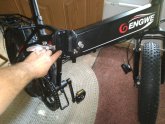offgriddle
"FOREVER BEGINNING"
I'm still performing testing and recording measurements on my "measurement question" post and thank you everyone for your help.
On a side note, this lithium powered bike came in this week. Because of the WWCFP, (World Wide Covid Flu Panic), the homesteady who purchased it had to order and wait a stupidly long tome for a slightly used one procured stateside! Clearly the bike was packaged by orangutans, loose parts were afloat inside the shipping damaged box and there wasn't even so much as a post it note included regarding assembly and operation!
Lucky I have fairly groovy electrical and mechanical aptitude and experience so I was able to put it together with only one part left over! We are still awaiting the requested PDF's on assembly and operation to be emailed from the California supplier of this quite plausibly well constructed, Chinese made bike!
Will the Bluetti 2400 have the chutzpah to charge this bike, operate a small freezer along with basic lighting and electronics for a cabin, all on a maximum of ten amps per hour charging input?
Yikes ...OG
...
On a side note, this lithium powered bike came in this week. Because of the WWCFP, (World Wide Covid Flu Panic), the homesteady who purchased it had to order and wait a stupidly long tome for a slightly used one procured stateside! Clearly the bike was packaged by orangutans, loose parts were afloat inside the shipping damaged box and there wasn't even so much as a post it note included regarding assembly and operation!
Lucky I have fairly groovy electrical and mechanical aptitude and experience so I was able to put it together with only one part left over! We are still awaiting the requested PDF's on assembly and operation to be emailed from the California supplier of this quite plausibly well constructed, Chinese made bike!
Will the Bluetti 2400 have the chutzpah to charge this bike, operate a small freezer along with basic lighting and electronics for a cabin, all on a maximum of ten amps per hour charging input?
Yikes ...OG
...




